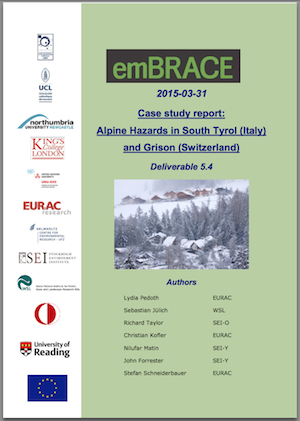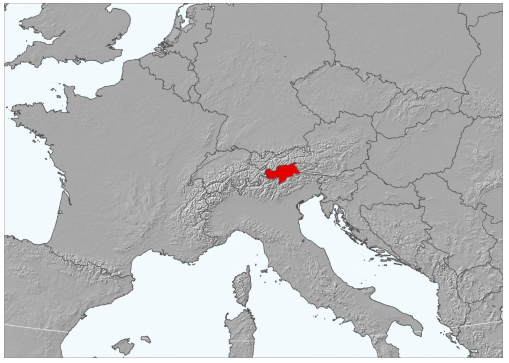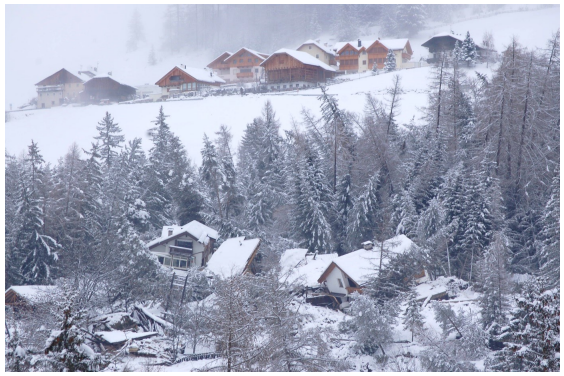Alpine Hazards in South Tyrol (Italy) and Grison (Switzerland) – emBRACE case study

This case study is part of the emBRACE project. In an interdisciplinary, socially inclusive and collaborative context, emBRACE aims to improve the framing of resilience in the context of disasters in Europe. The primary aim of the emBRACE project is to build resilience to disasters amongst communities in Europe. You can read more about the project here.
Introduction
In the Alps, natural hazards are part of everyday life and tied into local history and culture. They shape the livelihoods, identity and resilience of the community. Communities live with continuous risk and cope frequently with small, and sometimes major, impact events. Every year, different kinds of natural hazard events cause damages, losses and deaths. How to prepare for, cope with and recover from them are key questions for our society, particularly in mountain terrain. One aim of this case study is to link the knowledge about risk perception to risk management, because it can contribute to shape a more effective community response.
The Autonomous Province of South Tyrol
This case study focuses on the situation within the municipality of Badia in the Eastern part of the Italian Autonomous Province of Bolzano. This Province, also known as South Tyrol, lies at the geographic and cultural crossroads of northern and southern Europe.

The map highlights the location of South Tyrol in Italy in red. Source: Map created by EURAC based on data from the Autonomous Province of Bolzano/Bozen.
The small alpine community of Badia in December 2012 was hit by an exceptionally big landslide. The municipality lies in a very landslide-prone area and experienced several events in the past, one big landslide event in exactly the same area in 1821. Against this background, the researchers of the emBRACE project were particularly interested in people’s risk perception and if risk perception increased after the recently experienced event, as described in other studies in different contexts and referred to different types of natural hazards (Perry and Lindell, 1990; Becker et al, 2001; Johnston et al, 1999). Furthermore, risk perception is a major factor that influences people’s motivation to support or implement preparedness, prevention and adaptation measures in the context of natural hazards. Nevertheless, at the same time people tend to be less worried about risks they know and they are familiar with (Jurt, 2009). Besides risk knowledge and past experience, the project researchers wanted to investigate which other factors such as values, attitudes and feelings as well as cultural determinants influence natural hazard perception and risk attitude (Kuhlicke et al, 2011). These aspects are of particular value for the case study community as it belongs to a linguistic and cultural minority within the region of South Tyrol.

Photo of the landslide event in Badia in December 2012 – Destroyed residential buildings in the foreground. Photo credit: Christian Iasio.
Methodology
The case study was conducted using different methodologies and including both quantitative and qualitative approaches. For the assessment of community resilience, the following three methods were applied: – survey among all adult population of the municipality of Badia through questionnaires. – social network analysis. – semi-structured interviews including qualitative social network mapping.
Summary and Conclusions
Findings show that in the case study community Badia people have a high risk awareness, they are aware of living in an area of high risk and they know about past hazard events, some of them experienced them personnally while the majority has heard or read about it. Nevertheless, results show that before 2012 they did not expect a real event happening and as a consequence did not actively prepare for it by undertaking preparedness measures. While risk awareness is positively correlated with the age of respondents, elderly people being more aware of living in a high risk area, the perceived risk for future landsildes event is not related to age and is distributed in a similar way among all age groups: the most common answer was that they did not expect such an event happening. In line with this results is also the fact that people do not perceive themselves, as individuals, responsible for the mitigation and protection against natural hazards and the knowledge about existing mitigation and protection measures is quite low. Indeed, people have a high trust in authorities and civil protection actors and perceive them as responsible for mitigation and protection measures. The event experienced in 2012 had a huge impact on peoples’ risk perception, showing an increase especially for people that were affected directly by the landslide and for people that live in close proximity to the landslide area.
Key messages
– Results of the case study work show the importance of local and traditional knowledge for resilience building. The most important information sources for past hazard knowledge are other village members and family, resulting more important than media.
– The feeling of community belonging and the strong presence of social networks proved to be very important as a crucial support to deal with the impacts of natural hazard events and to contribute positively to community resilience.
– In terms of resilience, out of the findings the case study concludes that it is important to look not only at the short term after a disaster, but also to the mid and long term.
– Key factors for resilience turned out to be the existence of a local civil protection plan and regular emergency exercises, the fact that the core network needs little time to become active and fully operative, as well as the personal knowledge and trust in the other members of the network.
Citation:
Pedoth, L., Jülich, S., Taylor, R., Kofler, C., Matin, N., Forrester, J. and Schneiderbauer, S. 2015. Case study report: Alpine Hazards in South Tyrol (Italy) and Grison (Switzerland). Deliverable 5.4, emBRACE project
(0) Comments
There is no content